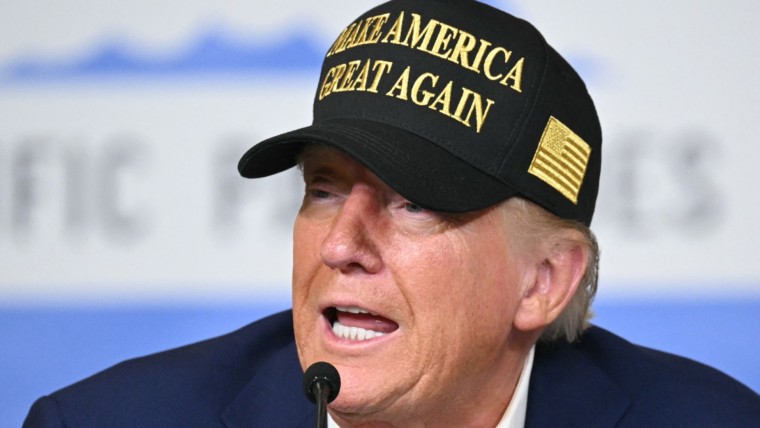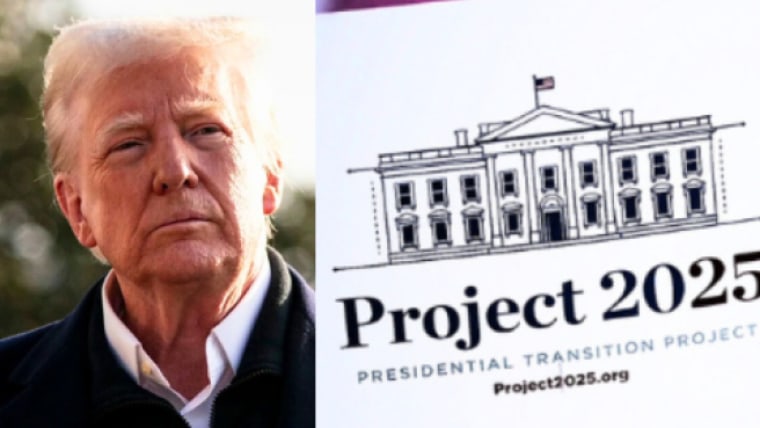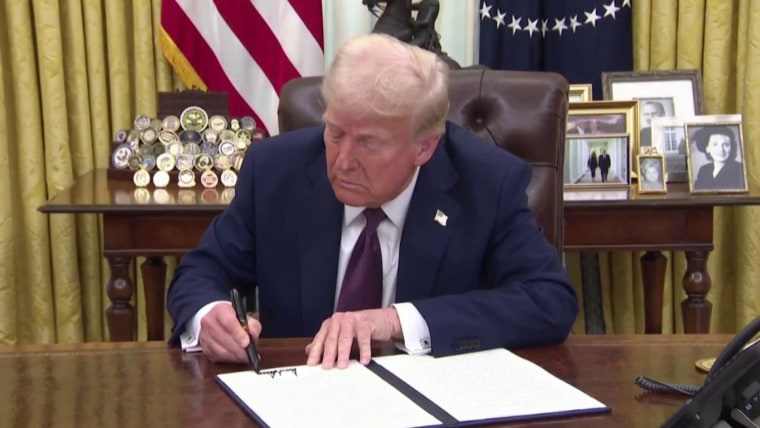As a candidate, Donald Trump said he knew "nothing" about Project 2025, the conservative playbook put together by a group of some of his former top advisers.
As president, he's following through on a lot of its ideas.
Some overlap between a Republican president and a conservative think tank's policy ideas would be expected, but Trump's immediate embrace of very specific ideas in the 900-page proposal makes his disavowals of it on the campaign trail seem disingenuous, at best.
In some cases, Project 2025 was building on Trump's ideas, as with its proposal to reimplement a plan from his first term to gain more control over federal workers. In other cases, such as withdrawing from a global tax deal, the Trump administration seems to be picking up on an idea in Project 2025 that the candidate hadn't said much about. And a few are standard Republican policies, such as enforcing the Hyde Amendment barring the use of taxpayer money to fund abortions.
That list is likely to grow. Just last week, Trump floated the idea of overhauling or eliminating the Federal Emergency Management Agency — in line with a proposal from Project 2025 to send more disaster funding directly to states.
Below, we took a look at Trump administration decisions that echo proposals from Project 2025, which we will be updating periodically.
Suspending refugee admissions
White House: Suspended the Refugee Admission Program, with the possibility of renewing it every 90 days based on the advice of the secretary of state. (Executive Order)
Project 2025: Proposed an “indefinite curtailment” of the number of refugees admitted under the U.S. Refugee Admission Program to shift resources to immigration enforcement. (p. 178)
Notable: The executive order cites Springfield, Ohio, where Trump falsely claimed immigrants were stealing and eating pets during the campaign.
Suspending asylum claims
White House: Suspended all claims of asylum at the southern border until the president issues a finding that “the invasion at the southern border has ceased.” (Executive Action)
Project 2025: Proposed raising the standards for “credible fear of persecution” for asylum-seekers and specifying that fear of gangs and domestic violence aren’t grounds for asylum. (p. 148)
Notable: The executive order doesn't use the word “asylum” at all, instead citing “section 208 of the INA, 8 U.S.C. 1158,” the section of U.S. law governing asylum claims.
Militarizing the southern border
White House: Directed the Defense Department to send active-duty military personnel and the National Guard to the southern border because of a “national emergency.” (Executive Action)
Project 2025: Proposed sending active-duty military personnel and National Guard members to “assist in arrest operations along the border” involving drug cartels. (p. 555)
Notable: The White House goes further than Project 2025, which only proposed that military personnel be considered to fight criminal organizations.
Sanctioning countries that don't accept deportees
White House: Threatened to impose tariffs on Colombia after President Gustavo Petro asked for migrants to be returned to the country on civilian planes and not military ones. (News)
Project 2025: Proposed "quickly and aggressively" imposing "stiff sanctions" on countries that refuse to accept deportees. (p. 167)
Notable: Project 2025 authors were notably split on whether or not tariffs are a good idea, with some favoring free trade and others taking a more populist approach.
Declaring there are only two genders
White House: Declared that the federal government will define gender as only male or female for purposes of federal documents and prison assignments. (Executive Order)
Project 2025: Proposed that Health and Human Services "proudly state that men and women are biological realities" (p. 489) and end programs that recognize transgender Americans. (p. 450)
Notable: The executive order defining gender as beginning "at conception" was criticized by scientists for being biologically inaccurate.
Drilling for oil and gas in Alaska
White House: Directed federal agencies to expedite permitting for oil and natural gas in Alaska, with a priority on liquefied natural gas projects. (Executive Order)
Project 2025: Proposed opening more areas of Alaskan wilderness owned by the federal government for oil and natural gas exploration and development. (p. 523)
Notable: Another executive order froze funding from two Biden-era laws that would have gone to clean energy projects in Alaska, including hydroelectric dams, wind turbines and solar energy.
Withdrawing from the Paris climate agreement
White House: Withdrew from the Paris climate agreement, including any related agreements and any financial commitments. (Executive Order)
Project 2025: Proposed ending a "global, climate-themed agenda" (p. 418) to the "perceived threat of climate change" (p. 419) by ending programs designed to meet the Paris climate agreement (p. 257).
Notable: Trump also withdrew the United States from the Paris climate agreement in his first term. President Joe Biden then signed an executive order rejoining it.

Withdrawing from the World Health Organization
White House: Withdrew from the World Health Organization, a specialized agency of the United Nations that focuses on global health. (Executive Order)
Project 2025: Proposed reducing support — "up to and including withdrawal" — for the WHO, which it argued showed a "manifest failure and corruption" during the pandemic. (p. 191)
Notable: Trump has attacked the WHO since 2020 over its approach to the pandemic and took steps in his first term to withdraw.
Withdrawing from a global tax deal
White House: Withdrew from a global corporate minimum tax deal under the Organization for Economic Cooperation and Development. (Executive Action)
Project 2025: Proposed withdrawing from the OECD entirely, calling it "little more than a taxpayer-funded left-wing think tank and lobbying organization." (p. 698)
Notable: The 2021 global tax deal was negotiated by the Biden administration with nearly 140 countries.
Ending protections for federal workers
White House: Reinstated an executive order creating Schedule F with minor changes and revoked another Biden-era executive order protecting federal workers. (Executive Order)
Project 2025: Proposed reinstating Schedule F, created by an executive order at the end of Trump’s first term, which gave the president more power to fire federal workers. (p. 80)
Notable: The executive order renames "Schedule F," which had become controversial, as "Schedule Policy/Career."
Ending diversity, equity and inclusion programs
White House: Ended diversity, equity and inclusion (or DEI) programs, mandates, policies, preferences and activities at federal agencies and targeted federal contractors. (Executive Order)
Project 2025: Proposed deleting the term “diversity, equity and inclusion” from every federal rule, regulation, contract, grant, regulation or legislation. (p. 3)
Notable: The Air Force briefly interpreted Trump’s order as requiring it to stop teaching about the Tuskegee Airmen and Women Airforce Service Pilots during World War II.

Freezing federal job hiring
White House: Ordered a hiring freeze on all federal civilian employees in the executive branch except the military or immigration, national security or law enforcement positions. (Executive Action)
Project 2025: Proposed a freeze on all top career-position hiring to "prevent 'burrowing in' by outgoing political appointees" and noted that several recent presidents began with hiring freezes. (p. 79)
Notable: Trump has also sought to reduce the federal workforce by ending work-from-home policies, an idea proposed in Project 2025 for only the Environmental Protection Agency’s lawyers. (p. 443)
Revoking security clearances
White House: Revoked the security clearances of dozens of former senior intelligence officials for signing an open letter in 2020 raising questions about Hunter Biden’s laptop. (Executive Order)
Project 2025: Stated that the intelligence community faced a "crisis of confidence" over the Hunter Biden story and called for revoking security clearances for people who talk with the media. (p. 213)
Notable: Trump also ended the Secret Service detail assigned to protect former national security adviser John Bolton from assassination threats from Iran.
Ending efforts to fight misinformation
White House: Ended federal efforts to fight misinformation, disinformation and malinformation, claiming they infringed on freedom of speech. (Executive Order)
Project 2025: Called for barring the FBI from engaging in any activities related to "combating the spread of so-called misinformation or disinformation." (p. 550)
Notable: Research doesn’t support the claim that conservatives are unfairly targeted by fact-checkers for spreading misinformation.
Ending gender-affirming treatments for teens
White House: Ended federal funding for gender-affirming care for children, including puberty blockers and hormones, and seeks to use other laws to limit or ban them. (Executive Order)
Project 2025: Proposed withdrawing all guidance encouraging medical providers to provide "gender transition" or "gender-affirming care." (p. 485)
Notable: The order also instructs law enforcement to look into using laws against female genital mutilation and consumer fraud to target gender-affirming care for adults.
Barring transgender troops from serving openly
White House: Banned transgender troops from serving in the armed forces, which would include the Army, Navy, Air Force, Marines, Space Force or Coast Guard. (Executive Order)
Project 2025: Recommended barring transgender troops from serving and expelling any member of the military with gender dysphoria. (p. 104)
Notable: The executive order also bars "the use of pronouns that inaccurately reflect an individual's sex."
Reinstating troops who didn't get vaccinated
White House: Allowed reinstatement of military service members discharged for refusing to get the Covid-19 vaccination mandated from 2021 to 2023. (Executive Order)
Project 2025: Recommended reinstating service members who were discharged for not receiving the vaccination. (p. 103)
Notable: The executive order also allows service members to have their previous rank restored and receive back pay.
Overhauling FEMA
White House: Created a council to launch a "full-scale review" of the Federal Emergency Management Agency and recommend "improvements or structural changes." (Executive Order)
Project 2025: Recommended moving FEMA to the departments of Interior or Transportation and shifting most preparedness and response costs to state and local government. (p. 135)
Notable: The council is specifically instructed to consider whether FEMA could just support states on disaster relief.

